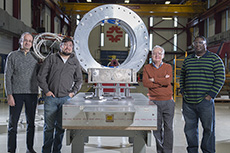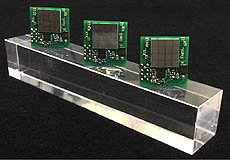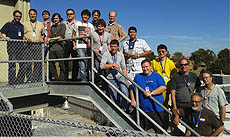Mu2e polishes off prototype module for transport solenoid
 |
| From left: Giorgio Ambrosio, Mau Lopes, Michael Lamm and Daniel Evbota show off the prototype coil module for the Mu2e transport solenoid. The prototype, here mounted on a test stand, will be one of 27 like pieces that guides muons to their target. Photo: Reidar Hahn |
Mau Lopes has never waited as anxiously for a package as he did for the one that arrived late last month. From the Italian laboratory INFN-Genoa came the completed prototype of one coil module for the s-shaped Mu2e transport solenoid.
The module is an aluminum ring about a meter wide and a meter deep, wound with hundreds of turns of superconducting cable. Twenty-seven modules joined together will generate the magnetic field that forms the experiment's winding muon path.
As a project manager, Lopes had been working on the ring for a year and a half.
"It's a really important milestone for us, and so far everything has been according to plan," Lopes said.
Mu2e collaborator INFN was charged with producing the superconducting coils and integrating them into the housing shell developed at Fermilab. Scientists Pasquale Fabbricatore, Stefania Farinon and Riccardo Musenich led the manufacturing effort and have delivered what looks to be an impeccable result. After Fermilab researchers test and approve the prototype, the Mu2e project will order the full production of coil modules to form the distinctive s-shaped mid-section of the 75-foot-long experiment.
All this is in an effort to fundamentally change the face of muon research. Fermilab has thrown in its bid to be the first to find the suspected but never confirmed direct conversion of one member of the lepton family into another, specifically, of muons to electrons. Analogous processes have been observed in other elementary particles, but this long-awaited breakthrough has yet to be discovered. Fermilab researchers, though, are confident in their plans.
"There's never been an experiment quite like this," said Michael Lamm, Mu2e solenoids project manager.
The fully assembled solenoid will generate a 2-Tesla magnetic field that will guide muons from their birthplace in the production solenoid to their target in the detector solenoid. As muons travel around the first bend, they separate from each other, allowing a collimator in the middle of the "s" to screen particles for charge and momentum. As selected muons travel around the second bend, they fall back into position to hit their target.
Getting the slight bend exactly right in each segment of the transport solenoid has been a major engineering challenge.
"This type of machining has never been done as far as we know," said Daniel Evbota, a Technical Division mechanical engineer assigned to the transport solenoid. "So communicating this type of machining in 2-D drawings or even in CAD models to our vendor was a big challenge."
Preliminary tests on the prototype will first check whether the magnetic field is properly aligned. In operation, researchers will power the module's superconducting coils with 2,000 amps of current and cool them to about 4 Kelvin.
Tests at that temperature are scheduled to take place in a few months, something Lopes and his team are once again eagerly awaiting.
—Troy Rummler
| 




